Best Budget Baby Dresser: SONGMICS 4-tier Storage Dresser
Let’s talk about buying nursery furniture. When you order a dresser online, you almost always have to assemble it yourself. In the business, these dressers are called “ready to assemble” (RTA) or knock-down (KD). Knock-down refers to the flat box the furniture is shipped in.
The big advantage for RTA or KD dressers for nurseries is price—these dressers are much less expensive than fully assembled dressers sold elsewhere.
The downside: you have to set your expectations accordingly. These dressers are not heirloom quality or made of expensive wood. You have to assemble it yourself. One important piece of advice: open the package and check for damage and missing parts immediately.
All the dressers recommended in this article come from reputable brands . . . but sometimes hardware goes missing or freight damage happens.
Ok, let’s get to the recommendations.
For best budget-friendly baby dresser, we like SONGMIC’s 4-tier storage dresser. This metal frame has eight fabric-covered drawer boxes. Simple, yet works well for baby clothes!
What We Liked
• Sturdy frame. Always anchor any furniture in your baby’s room to the wall! This dresser includes a no-tip strap. Use it!
• Lightweight. You can move this from room to room if you need to.
• Easy to assemble.
• Affordable.
• Fabric drawers = no pinching!
• Adjustable feet help level this dresser on uneven floors.
What Needs Work
• Fabric can pill. This is an issue with all fabric drawer dressers, of course. We thought the quality here is good.
Best 6 Drawer Baby Dresser: Storkcraft Avalon 6 Drawer Dresser
If you need more space for baby clothes, we’d recommend a six drawer dresser for your baby’s nursery. After reviewing a half dozen different options, we think Storkcraft’s Avalon is the best bet. The traditional sleigh design is a classic look and the top can fit a changing pad (sold separately). Here’s more:
What We Liked
• Sturdy.
• 6 drawers that are 17.5″ deep.
• Euro-glider drawers are easy to open.
• Easy on the wallet. Many six drawer dressers approach a mortgage payment. This one is easier on the wallet.
What Needs Work
• Inspect immediately for any shipping damage. This can happen with any nursery dresser, but be sure to open and inspect immediately. In our research, we found this isn’t a common problem for this dresser . . . but can still happen, nonetheless!
• Could be easier to assemble. Set aside some time and patience to assemble this dresser.
• Dresser isn’t made of solid wood. Instead this dresser is made of engineered wood and composites. There’s nothing wrong with that—it is just as safe and sturdy. The composite wood material keeps the price affordable.
• Color can vary. This is an issue with ordering any furniture online—depending on your computer monitor, the color of a dresser you see online may be slightly different in real life. Hence, some folks wanted a darker grey for this dresser than it is in reality.
Best 5 Drawer Baby Dresser: WLIVE Dresser with 5 Drawers
This smaller dresser with five fabric drawers can fit in small spaces: it’s just 11.8″ deep and less than 40″ wide. If you live in a small urban condo or apartment, this may be just the ticket!
What We Liked
• Easy to assemble.
• Black frame, dark grey baskets look sharp.
• Perfect size for baby clothes.
What Needs Work
• Doesn’t hold a lot of clothes. Well, that’s the trade off for the smaller, compact footprint!
Best Changing Table Dresser: Dream on Me Marcus Changing Table and Dresser
If space is tight, a combination dresser and changing table is a great solution—it does double duty in a small space.
We looked at a dozen different changing table dressers before picking Dream on Me’s Marcus changing table dresser as the best bet—we liked the raised safety rail for the changing table best. This is more secure than just putting a changing pad on the top of a regular dresser, in our opinion.
What We Liked
• 8 color options—grey, white, espresso and more.
• Classic sleight style.
• Good quality.
• Tools for assembly included.
• Includes 1″ changing pad.
• Nice height for changing diapers.
• Affordable.
What Needs Work
• Always inspect for missing parts and shipping damage upon arrival. This is true for all dressers, of course!
• Drawer glides could be a touch smoother.
Why Trust Us
We’ve been rating and reviewing nursery furniture since 1994. In addition to hands on inspections of nursery furniture, we have also visited manufacturer facilities and met with safety regulators—and when we travel, we pay our all of our own expenses.
Here’s another key point: we don’t take money from the brands we review. No free samples, no sponsors, no “partnerships.” Baby Bargains is your independent and unbiased source for expert baby gear reviews. We’ve been writing and reviewing baby gear since 1994. Yes, that long!
How we picked a winner
We evaluate nursery furniture, including dressers and chests, with in-depth inspections, checking models for overall quality and ease of use—for example, testing drawer glides and making sure drawers have dovetails and corner blocks. We also gather significant reader feedback (our book, Baby Bargains has over 1 million copies in print), tracking furniture on quality and durability. Besides interviewing parents, we also regularly talk with retailers of nursery furniture to see which brands are most trustworthy and other key quality metrics.
The reliability of nursery furniture companies is another key factor—we meet with key company executives at least once a year.
7 Things No One Tells You About Buying A Nursery Dresser!
1. Focus on drawer glides.
Test this in the store—drawers with an easy glide typically have tracks on BOTH sides of the drawer. Cheaper dressers have drawers that simply sit on a track at the bottom center of the drawer. As a result, they don’t roll out as smoothly and are prone to coming off the track. Look at the drawer glide itself. Cheaper dressers have simple metal glides.
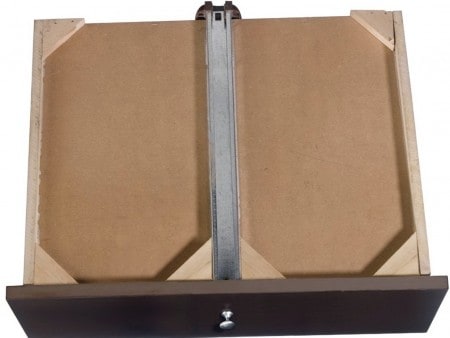
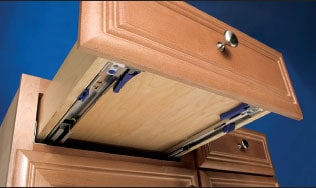
Better dressers use more elaborate mechanisms including ball bearings or self-closing glides (you push the drawer nearly closed and it automatically/slowly closes the rest of the way). A few dresser makers use wood-on-wood glides, more commonly seen in adult furniture; we don’t recommend this type of drawer glide.
2. Look closely at the sides of the drawer.
The best furniture makers use “dove-tailed” drawer joints. There are two types of dove-tail drawers: English and French (see pictures below). Both are acceptable. What’s not good? Drawers and drawer fronts that are merely stapled together.
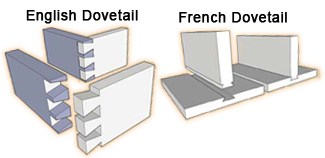
3. A third quality indicator is drawers with corner blocks.
Pull the drawer out and turn it over to look at the corners—if there is a small block that braces the corner, that’s good. Cheaper dressers omit this feature, which adds to the stability of the drawer.

4. Most shoppers never look at the back of a dresser.
You should. You might find the backing is just a flimsy piece of chipboard stapled to the frame. But if it’s a good quality piece of furniture, it will be a solid (although perhaps only 1/4″ thick) piece of wood that is screwed to the frame.
5. Medium density fiberboard (MDF) versus solid wood.
The best-made dressers have solid wood tops and drawer fronts (and some have solid wood sides).
Of course, solid wood is expensive. To make dressers more affordable, many furniture makers turn to substitute wood products such as medium density fiberboard (MDF). What is MDF? Basically, MDF is made from wood scraps that are turned into fiber and then glued together to form a solid board.
In addition to being affordable, MDF is easier to sculpt since it lacks knots or wood grain. Hence, you often seen MDF used in modern furniture groupings where a sleek, smooth aesthetic is the goal.
One downside to MDF: the glue or resin that is used to hold it together may contain formaldehyde. Back in 2008, five nursery furniture makers were sued by the state of California for unsafe levels of formaldehyde in their dressers.
Of course, not all glues are high in formaldehyde. Look for furniture manufacturers that are GREENGUARD certified to be low emission.
Our opinion: MDF isn’t necessarily good or bad. The more money you spend, however, should mean more solid wood and less MDF.
6. Skip buying a separate changing area and use a dresser.
Most folks look for dressers to do double duty: not only a place to store clothes, but also to change diapers. Basically, you need a changing area of the right height to do this—evaluate your and your spouse’s heights to see what you’d need (a lower side-by-side dresser or a taller chest). Then you can purchase a changing pad for your dresser top. Some pads have non-skid bases or you can screw the pad onto the dresser (we aren’t sure this is a good idea!).
7. Think twice about combination crib and dressers.
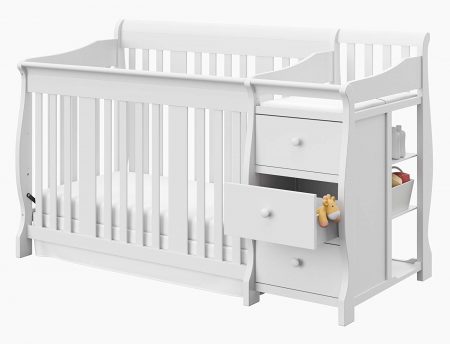
As the name implies, a combo crib and dresser is a crib with an attached dresser or changing area. This may sound like a good deal, but these combos are a safety risk, in our opinion. The hazard: babies can climb out of them too easily, based on reports to a government safety database we reviewed. Clever babies can get a toe hold on the railing or dresser drawer and push themselves up to the top of the dresser. From there, nothing good can happen.
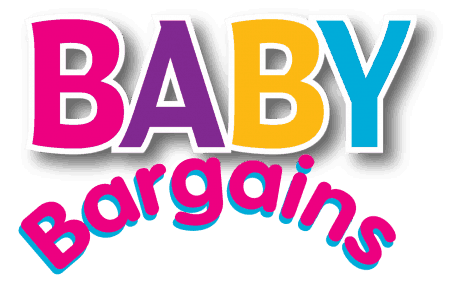

 We obsess over baby gear . . . so you don’t have to. Baby Bargains has one mission: help you find the best gear for your baby with unbiased reviews by experts with 20 years of experience. At prices that don’t break the bank. When you purchase a product from links on this site, we make a small affiliate commission. Learn more
We obsess over baby gear . . . so you don’t have to. Baby Bargains has one mission: help you find the best gear for your baby with unbiased reviews by experts with 20 years of experience. At prices that don’t break the bank. When you purchase a product from links on this site, we make a small affiliate commission. Learn more 
